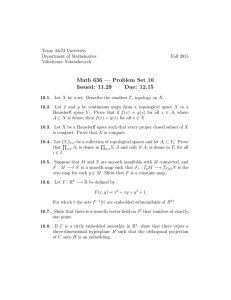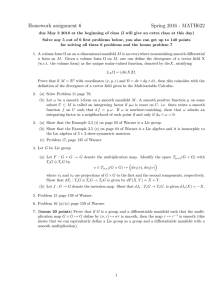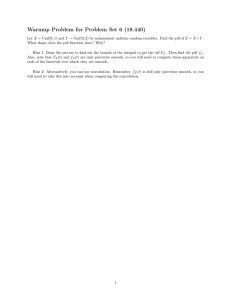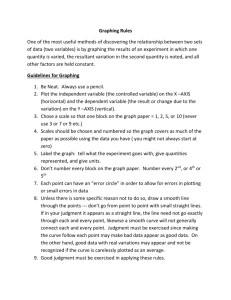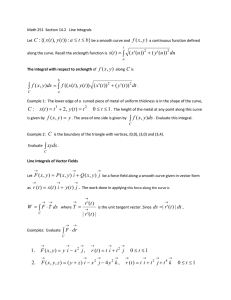TEMPERED GROUPS by Josef Teichmann
advertisement
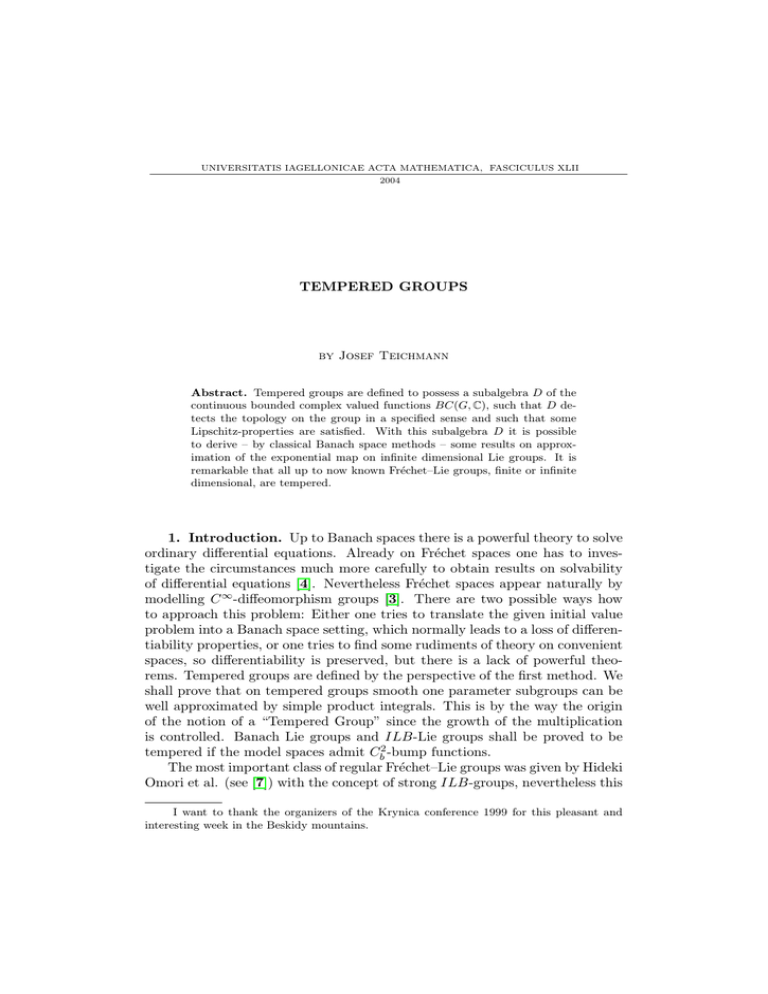
UNIVERSITATIS IAGELLONICAE ACTA MATHEMATICA, FASCICULUS XLII
2004
TEMPERED GROUPS
by Josef Teichmann
Abstract. Tempered groups are defined to possess a subalgebra D of the
continuous bounded complex valued functions BC(G, C), such that D detects the topology on the group in a specified sense and such that some
Lipschitz-properties are satisfied. With this subalgebra D it is possible
to derive – by classical Banach space methods – some results on approximation of the exponential map on infinite dimensional Lie groups. It is
remarkable that all up to now known Fréchet–Lie groups, finite or infinite
dimensional, are tempered.
1. Introduction. Up to Banach spaces there is a powerful theory to solve
ordinary differential equations. Already on Fréchet spaces one has to investigate the circumstances much more carefully to obtain results on solvability
of differential equations [4]. Nevertheless Fréchet spaces appear naturally by
modelling C ∞ -diffeomorphism groups [3]. There are two possible ways how
to approach this problem: Either one tries to translate the given initial value
problem into a Banach space setting, which normally leads to a loss of differentiability properties, or one tries to find some rudiments of theory on convenient
spaces, so differentiability is preserved, but there is a lack of powerful theorems. Tempered groups are defined by the perspective of the first method. We
shall prove that on tempered groups smooth one parameter subgroups can be
well approximated by simple product integrals. This is by the way the origin
of the notion of a “Tempered Group” since the growth of the multiplication
is controlled. Banach Lie groups and ILB-Lie groups shall be proved to be
tempered if the model spaces admit Cb2 -bump functions.
The most important class of regular Fréchet–Lie groups was given by Hideki
Omori et al. (see [7]) with the concept of strong ILB-groups, nevertheless this
I want to thank the organizers of the Krynica conference 1999 for this pleasant and
interesting week in the Beskidy mountains.
56
concept is rather complicated in application. For the concepts of convenient
calculus and Frölicher spaces (smooth spaces) see [3].
Definition 1. A Lie group G is a smooth manifold modeled on c∞ -open
subsets of a convenient vector space with smooth multiplication µ : G × G → G,
where µ(x, y) = xy, and smooth inversion ν : G → G, where ν(x) = x−1 , for
x, y ∈ G. We shall denote by µx : G → G and µy : G → G the smooth left and
right translation by an element of G, i.e. µx (y) = µy (x) = µ(x, y) for x, y ∈ G.
Remark that Lie groups are not topological groups in general, because the
identity c∞ (E×E) → c∞ E×c∞ E need not be a homeomorphism (see [3], ch.1).
If the Lie group G is a topological group, then the underlying topological space
is regular (since any Hausdorff topological group is regular, see [6]), but not
necessarily smoothly regular, and we can assume, that a chosen chart (u, U )
has the property that inverse images of closed bounded sets in the convenient
vector space are closed in the group, not only relatively closed in U ⊂ G. We
shall need this property to be able to lift functions from the convenient vector
space to the group.
The classical basics of Lie theory can be carried over to this general setting
without any problems (see [3], ch. 8): Via left or right translation one can
trivialize the kinematic tangent bundle T G = G × g, where g denotes the
tangent space at the identity e. This is done by left invariant vector fields
(X ∈ C ∞ (G ← T G) is called left invariant if T µx X = X ◦ µx or equivalently
µ∗x X = X for x ∈ G) or right invariant vector fields. g becomes a Lie algebra,
isomorphic to the Lie algebra of left invariant vector fields and antiisomorphic
to the Lie algebra of right invariant vector fields on G (X ∈ C ∞ (G ← T G)
is called right invariant if µx∗ X = X for x ∈ G). We denote the (anti-)
isomorphism by L (respectively R). We have the following formulas for x ∈ G:
d
d
|t=0 xc(t) and R(X)x = |t=0 c(t)x
dt
dt
for X ∈ g and a curve c : R → G with c(0) = e and c0 (0) = X.
An exponential mapping is a map exp : g → G, so that F lL(X) (t, x) =
x exp(tX) is the global flow of the left invariant vector field L(X). An exponential mapping is unique if it exists, remark that the global flow of R(X) is
given through F lR(X) (t, x) = exp(tX)x. Furthermore we obtain for a smooth
group homomorphism φ of groups, which admit an exponential mapping, the
formula exp(φ0 (X)) = φ(exp(X)) for X ∈ g .
L(X)x =
Definition 2. Let G be a Lie group with Lie algebra g. The conjugation
by an element x ∈ G defined through conjx (y) = xyx−1 for y ∈ G is a smooth
group automorphism. Adx := conjx 0 defines a smooth representation Ad : G →
GL(g). The adjoint representation Ad of the group maps into the subspace of
57
smooth Lie algebra automorphisms. The derivative of Ad (even in the sense
of smooth groups) is ad : g → L(g). The adjoint representation ad of the Lie
algebra maps in the subspace of derivations of the Lie algebra g.
A smooth group or Frölicher–Lie-group is a group G with the structure of a
smooth space (for this concept see [3], ch. 5), such that the multiplication and
the inversion are smooth. All smoothly regular Lie groups are smooth groups
in a canonical way. The group GL(E) of invertible linear bounded maps on
a convenient vector space E is a standard example, and not a Lie group in
general, with the following smooth structure:
CGL(E) := {c : R → GL(E)|c : R → L(E) and inv ◦ c : R → L(E) are smooth},
FGL(E) := {f : GL(E) → R|f ◦ c ∈ C ∞ (R, R) for all c ∈ CGL(E) }.
Notice that the restrictions of all linear functionals on L(E) lie in FGL(E) ,
furthermore the restriction of the composition of a linear functional with the
inversion lies in FGL(E) , so GL(E) becomes a smooth space. Multiplication
and inversion are smooth. A smooth map f : G → H between Frölicher–Liegroups is called initial if for any curve c : R → G with f ◦ c smooth smoothness
of c is implied. The following example might explain the interest in smooth
groups:
Q
Example 3. The ∞-Torus k∈N S 1 is a smooth group with smooth curves
being the componentwise smooth ones. The ∞-Torus is a product in the category of locally compact topological groups and a product in the category of
smooth groups. Furthermore the ∞-Torus can never be made to a manifold,
because it should be infinite dimensional and locally compact.
Remark 4. Let G be a convenient smootly regular Lie group and denote
by Ad : G → GL(g) the adjoint representation. If Ad is initial, i.e. Ad ◦ c
smooth for a curve c : R → G implies smoothness of the curve, then the inner
automorphisms Inn(g) := Ad(G) constitute a Frölicher–Lie-group diffeomorphic to G in the category of Frölicher–Lie groups. This is due to the fact that
the Frölicher–Lie structure is induced by the general linear group GL(g) and
well-defined, the diffeomorphism is given by Ad.
Proposition 5. Let M denote a compact finite-dimensional manifold and
Diff(M ) the Fréchet–Lie group of diffeomorphisms of M , then Ad : Diff(M ) →
GL(X(M )) is an initial map, so Diff(M ) is canonically isomorphic to the
Frölicher–Lie-group of inner automorphisms.
Proof. The proof is done in several steps: First we prove that a curve
c in G with Ad ◦ c smooth has the following property: For any t0 ∈ R, x0 ∈
M and any open neighborhood V of c−1 (t0 , x0 ) there is δ > 0 and an open
neighborhood U of x0 with c−1 (t, x) ∈ V for |t − t0 | < δ and x ∈ U . Otherwise
58
there would exist t0 ∈ R, x0 ∈ M , an open neighborhood V of c−1 (t0 , x0 ) and
sequences tn → t0 and xn → x0 with c−1 (tn , xn ) ∈
/ V . Now take a vector field
−1
X on M having support in V with X(c (t0 , x0 )) 6= 0. The formula for the
action of Ad on vector fields is
Adct (X)(x) = Tc−1 (t,x) ct (X(c−1 (t, x)).
Consequently Adctn (X)(xn ) = 0 for all n, but Adct0 (X)(x0 ) 6= 0. However,
Adct (X) is smooth, so a smooth curve of smooth sections in the tangent bundle,
a contradiction.
Second step: it is sufficient to prove the following fact: Let c be a curve
passing at t = 0 through e with Ad ◦c smooth, then there is a neighborhood
of 0, where the curve is smooth. From this we conclude easily the general case
by looking at the smoothness of the composition and the curve c−1
t0 c around
t0 .
Third step: we apply the first observation to prove the assertion of the
second step: Let c be a curve passing at t = 0 through e with Ad ◦ c smooth,
then there is a chart domain V ⊂ M , open around x0 = c−1 (0, x0 ) mapped to
a ball in Rn , furthermore δ > 0 and an open neighborhood U ⊂ V of x0 with
c−1 (t, x) ∈ V for |t| < δ and x ∈ U . Smoothness of Ad ◦ c locally can be read
as follows
−1 ∂
) is smooth for i = 1, ..., n.
(Tx c−1
t ) (
∂xi
∂(c−1 )j )
t
This means, by smoothness of the inversion of matrices, that ( ∂x
(x)) is
i
smooth locally around x0 and 0. Consequently by compactness of the manifold
we conclude that there is a small interval around zero where c−1
t is a smooth
curve of diffeomorphisms, so ct is smooth.
Since we do neither possess any information on the initiality of Ad in
general nor on some good other linear representation, which induces a strongly
continuous Banach space representation, we shall try to construct a subspace
of the bounded continuous functions, on which G acts faithfully, to be able to
apply some Banach space methods to obtain the existence of the exponential
map.
2. Tempered groups. We shall apply a remarkable theorem of Paul
Chernoff on the approximation of C0 -contraction semigroups on a Banach space
X (see [1]):
Theorem 6. Let X be a Banach space, and c : R≥0 → L(X) a curve of
uniformly power-bounded operators, i.e. there is s0 > 0 and M ≥ 1 such that
||c(t)n || ≤ M for t ∈ [0, s0 ] and n ∈ N. If there is a dense subset D ⊂ X such
59
that
c(t)x − x
= Ax for x ∈ D
t
and there is λ0 > 0 with (λ0 − A)D dense in X, then A is the infinitesimal
generator of a strongly continuous semigroup T and
t n
s-limn→∞ c( ) = Tt
n
uniformly on compact subsets of R≥0 .
lim
t↓0
The following Theorem is needed for approximation on convenient vector
spaces as stated in the following corollary (see [8] for the proofs):
Theorem 7. Let E be a convenient vector space and c : R≥0 → L(E) a
smooth curve of bounded linear mappings with c(0) = id such that there exists
s > 0 with {c( nt )n | n > 0, 0 ≤ t ≤ s} a bounded set of bounded linear mappings,
then there is a smooth semigroup T : R≥0 → L(E) with infinitesimal generator
c0 (0) and
t n
limn→∞ c
= Tt
n
in C ∞ (R≥0 , L(E)).
Corollary 8. Let G be a smoothly regular, convenient Lie group (with
being a topological group) and c : R≥0 → G a smooth curve with c(0) = e
such that there exists s > 0 with {c( nt )n | n > 0, 0 ≤ t ≤ s} relatively compact
in the smooth topology, then there are a smooth group Tt = limn→∞ c( nt )n of
G and a chart (u, U ) around e with the following properties: There is small
> 0 such that {c( nt )n | n > 0, 0 ≤ t ≤ } ⊂ U and u(c( nt )n ) converges in all
derivatives to u(Tt ) for 0 ≤ t ≤ .
c∞ G
We shall work in the Banach space BC(G) of continuous complex valued
bounded functions on G normed by the supremum norm. Given X ∈ g, there
is a smooth one-parameter subgroup exp(tX) of G, if G admits an exponential
map. We shall investigate the group T of linear operators on BC(G) given by
Tt (f )(x) := f (exp(tX)x) = (f ◦ µexp(tX) )(x) for all x ∈ G, f ∈ BC(G)
for t ∈ R. For a given smooth curve c : R → G with c(0) = e and c0 (0) = X
we can proceed in the same manner, so we obtain a curve C of isometries
on BC(G). To be able to apply Chernoff’s theorem, we need an appropriate
domain D in BC(G), such that D detects the topology of G in a certain sense
and satisfies certain properties concerning translations. This leads us to the
concept of tempered groups. It is clear that the above one-parameter subgroup
has some dense domain of definiton for the infinitesimal generator. That the
intersection of all these maximal domains is again dense in the case of all strong
ILB-groups is the result of this section.
60
Definition 9 (tempered groups). A smooth group G is said to be tempered
if it is a smooth space and if a unital subalgebra D ⊂ BC(G) is given, such
that the following conditions are satisfied.
1. D is invariant under left translations, that means f ◦ µa ∈ D for all
f ∈ D and a ∈ G.
2. D detects the converging sequences on G:
∀ {xn }n∈N , x ∈ G : sup |f (xn y) − f (xy)| → 0 for all f ∈ D ⇒
y∈G
xn converges to x in G.
3. For every smooth curve c : R → G with c(0) = e the curve C : R →
L(BC(G)) of left translations by c(t) for t ∈ R is differentiable at f ∈ D
for t = 0 in the supremum-norm topology of BC(G).
Lemma 10. Let G be a tempered group and c : R → G a smooth curve, then
c is continuous and C : R → L(BC(G)) is differentiable at f ∈ D for all t ∈ R.
Proof. Let c : R → G be a smooth curve, then b(t) := c(t)c(0)−1 for
t ∈ R is a smooth curve with b(0) = e, so B : R → L(BC(G)) is differentiable
at f ∈ D for t = 0. So for any f ∈ D there exists g ∈ BC(G), such that
sup |
x∈G
f (c(t)c(0)−1 x) − f (x)
t→0
− g(x)| → 0,
t
consequently by left translation we obtain
sup |
y∈G
f (c(t)y) − f (c(0)y)
t→0
− g(c(0)y)| → 0,
t
which is the desired assertion. The rest follows by property 2.
Lemma 11. Let G be a topological group, U ⊂ G an open neighborhood
of e. Then there is a neighborhood V ⊂ G of e, such that for any continuous
curve c : R → G with c(0) = e one can find a small open interval J around
zero with ∪t∈J c(t)−1 V ⊂ U .
Proof. The mapping G × G → G, (g, h) → g −1 h is continuous, so the
conclusion follows immediately.
The following proposition asserts that on tempered topological groups
smooth one parameter groups can be well approximated:
Proposition 12. Let G be a tempered group (with c∞ G a topological
group). Let c : R → G be a smooth curve with c(0) = e touching a smooth
one-parameter group S at t = 0, more precisely
∀ f ∈ D, x ∈ G : (f ◦ µx (c))0 (0) = (f ◦ µx (S))0 (0).
61
Then we obtain
t n
lim c( ) = St
n→∞
n
n
uniformly on compact subsets of R, i.e. c( nt ) S−t converges to e as n → ∞
uniformly on compact subsets of R. If G is a smoothly regular tempered Lie
n
group, then the convergence of c( nt ) to St is uniform in all derivatives.
Proof. The first part of the proof is a simple application of the core
theorem, which asserts that the closure of the restriction of an infinitesimal
generator of a strongly continuous semigroup to an invariant and dense subspace is the infinitesimal generator (see [1]). We shall denote the closure of
the subspace D ⊂ BC(G) by X. C and T denote the curves of contractions
on BC(G) given by left translation with c(t) and S(t), respectively. By property 1 D is invariant under the action of C(t) and T (t) for t ∈ R, by property
3 the first derivatives of C and T at t = 0 exist pointwise for f ∈ D and they
coincide. So T |X defines a C0 -group on X, C|X is a curve of contractions on
X. D is a dense, T |X -invariant subspace of the domain of the infinitesimal
generator of T , consequently the closure of the restriction of the infinitesimal
generator to D is the infinitesimal generator. The application of Chernoff’s
theorem leads to
t n
lim (C|X ( )) (f ) = (T |X )t (f )
n→∞
n
for all f ∈ X uniformly on compact subsets of R. In fact we have to apply the
theorem twice to obtain the assertion for the whole real line. By property 2
we are lead to the existence of the limit in the group G uniformly on compact
subsets of R. Uniformity is due to our specified detection of the topology of G.
Suppose that the sequence does not converge uniformly on a given compact
interval K to the limit e, so there is an open neighborhood U of e and sequences
{nk }k∈N , a monotone, diverging sequence of natural numbers, and {tk }k∈N in
n
K, so that c( ntkk ) k S−tk ∈
/ U for k ∈ N, but
sup |f (c(
x∈G
tk nk
k→∞
) x) − f (Stk x)| → 0
nk
by the convergence theorem. Consequently
tk nk
k→∞
sup |f (c( ) S−tk y) − f (y)| → 0
n
k
y∈G
which leads by 2 to a contradiction. So the limit exists uniformly on compact
subsets of R. By Theorem 7 and its Corollary 8 the smoothly regular case is
already proved, we give another perspective in the general case, too.
Let G be additionally a Lie group, then the adjoint representation Ad maps
sequentially smoothly compact sets to bounded ones, since it is continuous with
respect to the smooth topologies (see [3]).
62
We denote by Y ∈ g the generator of St = exp(Y t). As established above
we know that limn→∞ cn (t) = exp(Y t) uniformly on compact subsets of R. The
rest of the proof is devoted to the uniform convergence on compact intervals of
δ r cn (t) to Y as n → ∞. In fact it is an easy consequence of calculations with
right logarithmic derivatives: For smooth curves c, d : R → G we have
δ r (cd)(t) = δ r c(t) + Adc(t) δ r d(t)
for t ∈ R. Consequently we obtain
1
δ r cn (t) =
n
n−1
X
!
Adic( t )
i=0
n
t
δ r c( )
n
for all t ∈ R. The adjoint action of G maps sequentially compact to bounded
sets in L(g), so there is a bounded absolutely convex subset B ⊂ L(g) so
that Adc( t )n S−t ∈ B for t in a closed zero neighborhood. By the general
n
approximation theorem on convenient algebras we obtain the following Mackeylimit:
lim Adnc( t ) = AdSt
n→∞
n
uniformly on compact subsets of R. The sequence measuring Mackey-conver2
gence is given by { tn }n∈N+ on the interval [0, t]. To conclude we look at the
Rt
above sum as an approximation of the integral 1t 0 AdSs ds for t 6= 0 in the
convenient algebra L(g). In fact we can choose n0 big enough, so that for
n ≥ n0 the approximation of the limit AdSt by Adcn (t) is good enough. By
uniformity of the respective limits, we obtain that
n0
n−1
n−1
n−1
X
X
t X
t X i
Adic( t ) +
(Adic( ti ) − AdS ti ) +
AdS ti
(
Adc( t ) ) = (
n
n
n
n
in
n
n
i=0
i=0
i=n0
i=n0
converges Mackey to the integral uniformly on compact subsets. Consequently
Z
1 t
lim δ r cn (t) =
AdSs ds Y = Y
n→∞
t 0
uniformly on compact subsets of R. So the assertions are proved. On the way
we obtain naturally c0 (0) = Y .
There is a general simple method to detect differentiability on Banach
spaces, which is in fact valid for much more general situations (see [2] for
details).
Lemma 13. Let E be a Banach space, S ⊂ E 0 a norming subspace of the
dual space, i.e. kxk = sup{|l(x)| | l ∈ S and klk ≤ 1}. Let I ⊂ R be an open
bounded interval, then a curve c : I → E is Lipn for a given n ∈ N if there
63
are curves ci : I → E for 1 ≤ i ≤ n + 1 with (l ◦ c)(i) = l ◦ ci for l ∈ S and
1 ≤ i ≤ n + 1 and cn+1 is bounded on I. In this case c(i) = ci for 0 ≤ i ≤ n.
Theorem 14. Let E be a Banach space, which admits Cb2 -bump functions,
then any Lie group modeled on E is tempered.
Proof. We denote by B(0, r) for r > 0 the open ball around zero in E.
The linear space of Cb2 -functions with values in C and support in B(0, r) having
bounded first and second derivative is denoted by Cb2 (r)(E). If the Banach
space admits Cb2 -bump functions, Cb2 (r)(E) detects the converging sequences:
n→∞
n→∞
xn → x ⇐⇒ φ(xn ) − φ(x) → 0 for all φ ∈ Cb2 (r)(E)
for all sequences {xn }n∈N and x ∈ B(0, r). Now we take two charts (u1 , U1 ),
(u2 , U2 ) mapping 0 to e around e of the Banach–Lie group, so that the C ∞ function µ0 := u2 ◦ µ ◦ (id × u1 −1 ) : U3 × B(0, 1)) → B(0, 1), where U3 ⊂ G is
an open chart domain of E, has the property that µˇ0 : B(0, 1) → C ∞ (U3 , E)
is globally Lipschitz and consequently bounded. This is possible by applying
Theorem 12.7 in [3] and the fact that Lip0 -functions on a Banach space with
values in a convenient vector space are locally Lipschitz around any point in
the domain of definition.
Let φ ∈ Cb2 (1)(E) be a bump function and c : R → E with c(0) = 0 a
smooth curve, then C: I ⊂ R → BC(B(0, 1)), given by Ct (f )(x) = f (µ0 (c(t), x))
for x ∈ B(0, 1), t ∈ I and f ∈ BC(B(0, 1)), where I is a sufficiently small open
interval around zero (so that c(t) ∈ U3 for t ∈ I), is differentiable at φ on I.
This will be detected by point evaluations evx for x ∈ B(0, 1), which span a
norming subspace for the supremum norm on BC(B(0, 1)):
d
evx (Ct (φ)) = dφ(µ0 (c(t), x))(d1 µ0 (c(t),x) (c0 (t)))
dt
d2
evx (Ct (φ)) = d2 φ(µ0 (c(t), x))(d1 µ0 (c(t),x) (c0 (t)), d1 µ0 (c(t),x) (c0 (t)))
dt2
+ dφ(µ0 (c(t), x))(d21 µ0 (c(t),x) (c0 (t), c0 (t)))
+ dφ(µ0 (c(t), x))(d1 µ0 (c(t),x) (c00 (t)))
for t ∈ I and x ∈ B(0, 1). The right hand side of the respective derivative is
the evaluation of a curve to BC(B(0, 1)), because the linear parts are bounded
in E. Consequently evφ ◦C : I → BC(B(0, 1)) is Lip1 on I for all φ ∈ Cb2 (1)(E)
by the previous lemma. Now we lift Cb2 (r) to the group G with the chart map
u2 given around e, where 0 < r < 1 is chosen sufficiently small: We chose 0 <
r1 < 1 so that u2 −1 (B(0, r1 )) ⊂ U1 . Applying the topological lemma leads to
0 < r < r1 , so that for every continuous curve c : R → G with c(0) = e there is a
small interval J around zero with ∪t∈J c(t)−1 [u2 −1 (B(0, r))] ⊂ u2 −1 (B(0, r1 )).
64
To prove differentiability we take φ ∈ Cb2 (r)(E), the lifting ψ = φ◦u2 ∈ BC(G)
has support in u2 −1 (B(0, r)). Let c : R → G be smooth with c(0) = e, then
there is J, open around zero with the above property, let g denote the lifting
of the first derivative along the curve c of φ at t = 0, then
x∈G
ψ(c(t)x) − ψ(x)
ψ(c(t)x) − ψ(x)
− g(x)| = sup |
− g(x)|
t
t
x∈U1
=
sup |
sup |
x∈B(0,1)
φ(µ̌(c(t), x)) − φ(x)
− dφ(µ(e, x))(d1 µ̌(e,x) (c0 (0)))|
t
for t ∈ J. Hence we obtain differentiability of evψ ◦ C : R → BC(G) at t = 0
for ψ = φ ◦ u2 with φ ∈ Cb2 (r) by Taylor’s remainder theorem. We obtain
that for every smooth curve the associated left translations are everywhere
differentiable at the lifted functions. Cb2 (r) is an algebra, by lifting, moving
the elements via left translation and associating the unit we can generate a
unital subalgebra of BC(G), which will be denoted by D.
We have to prove the assertions of Definition 9: 1 is clear by definition,
2 is clear by the structure of Cb2 (r) as the translated functions detect every
converging sequence, 3 is clear up to the following consideration. Let c : R →
BC(G) be a smooth curve with c(0) = e, y ∈ G. Let φ be in the lifting of
Cb2 (r) to the group, then there is g ∈ BC(G), such that
sup |
x∈G
φ(yc(t)x) − φ(yx)
t→0
− g(x)| → 0.
t
Consequently the curve C is differentiable on the left translation by y of φ on
G, because it is differentiable along the curve yc(.) as remarked before. So all
the properties are proved and the Banach–Lie group is tempered.
Theorem 15. Let G be a smooth group structure, where c∞ G is a topological group, G = proj limα∈Ω Gα , where the Gα are topological groups, the limit
is given in the category of topological groups.
If Gα is a Banach manifold modeled on a Banach space Eα , which admits Cb2 -bump functions for α ∈ Ω, and if the canonically given multiplication
µα : G × Gα → Gα is smooth, then G is a tempered group.
If furthermore the C ∞ -vector fields
Xxα :=
d
|t=0 µα (c(t), x)
dt
for x ∈ Gα are globally integrable on Gα for every smooth curve c : R → G
with c(0) = e and α ∈ Ω, then for every smooth curve c : R → G with c(0) = e
there is a continuous group T and
65
t n
lim c( ) = Tt
n→∞
n
uniformly on compact intervals in R.
Proof. We proceed by the same method as in the preceding examples, but
we have to look carefully at the multiplication µα for a given α ∈ Ω. There
are charts u1 , u2 for the group Gα around e and a open chart domain U3 ⊂ G
around e, so that µ0α = u2 ◦ µα ◦ (id × u1 −1 ) : U3 × Bα (0, 1) → Bα (0, 1). By
shrinking the chart (u1 , U1 ) we may assume that ǔα : Bα (0, 1) → C ∞ (U3 , Eα )
is globally Lipschitz. Now we can apply the same method as before: We take
the algebra Cb2 (r)(Eα ), where 0 < r < 1 is chosen sufficiently small due to the
above consideration. We calculate the derivatives under evaluations and prove
differentiability in BC(Bα (0, 1)) of curves of left translations by a smooth curve
at functions from Cb2 (1)(Eα ). We lift the algebra Cb2 (r) on the group Gα and –
via the canonically given smooth projections – from Gα to G. Finally we arrive
at the differentiability properties. Redoing the program for all α ∈ Ω, moving
around the functions concentrated at the identity and using the properties of
the projections and the limit leads to a subalgebra D ⊂ BC(G), which proves
temperedness of G.
Assume now that the described C ∞ -vector fields are globally integrable
on Gα . Redoing the first part of the proof we can find a unital subalgebra
Dα ⊂ BC(Gα ), which satisfies 1 and 2 of Definition 9, the third property is
satisfied only for smooth curves c : R → G with c(0) = e, which are projected
to Gα (The resulting curve is denoted by cα ). It is worth mentioning that we
are not given the structure of a tempered group, because the multiplication on
Gα is not smooth.
Fix now a smooth curve c : R → G with c(0) = e to construct X α . We
denote the global flow associated to X α by T α . By inserting in functions
of Dα we have the problem that the T α are not translations, but we can
d
d α
Tt (x) = ds
|s=0 µα (c(s), Ttα ). The exact formulation of
argue directly as dt
the above construction leads to curves C : R → BC(Gα ) which are two times
differentiable under the evaluations evx for x ∈ Gα on a small interval around
zero on functions φ ∈ Dα , where the derivatives lie in BC(Gα ), the second one
is bounded on the interval. Given φ ∈ Dα and x ∈ Gα we obtain
d
φ(Ttα (x)) = (C 0 (0)φ)(Ttα (x))
dt
d2
2
φ(Ttα (x)) = (C 0 (0) φ)(Ttα (x))
dt2
for t in the interval. The right hand sides are bounded on the interval, so
we conclude that the given curve is differentiable in BC(Gα ). We shall look
66
at the closure of Dα in BC(Gα ), an algebra of differentiable functions concentrated at a small neighborhood, so we are able to detect convergence in a small
neighborhood of the identity. By a slight generalization of Chernoff’s theorem
(we leave away the condition A|D = A, but obtain only convergence on the
closure of D) we arrive at uniform convergence on compact subsets of a small
neighborhood of the identity of the following limit:
t n
lim cα ( ) = Ttα (e).
n→∞
n
This means that the limit exists uniformly on compact subsets of R due to
continuity of the multiplication. Therefore we have proved that the right hand
side of the limit is a continuous group in Gα . The above procedure can be done
for any α ∈ Ω, consequently we have proved the assertion by the properties of
the limit, more precisely: There exists a continuous group T α on Gα with the
n
property limn→∞ cα ( nt ) = Ttα , satisfying the limit conditions. So we can lift
it to G and there we obtain the desired equation.
Corollary 16. All strong ILB-Lie groups, where the respective Banach
spaces in the chain admit Cb2 -bump functions, are tempered.
Proof. See [7] for the properties of strong ILB-groups. In particular we
get into the assumptions of Theorem 15, since a strong ILB-Lie group is the
projective limit proj limn Gn = G of topological groups Gn , which are Banach
manifolds, and µn : G × Gn → Gn are smooth for n ≥ 0.
On tempered Lie groups we can easily characterize the existence of an
exponential mapping.
Theorem 17. Let G be a tempered Lie group (in particular smoothly Hausdorff ). Let D ⊂ BC(G) be the given unital subalgebra. Let G satisfy the following completeness condition: If {xn }n∈N is a sequence with f ◦ µxn a Cauchy
sequence in BC(G) for f ∈ D, then there is x ∈ G with xn → x as n → ∞.
Then the Lie group admits a smooth group in each direction if and only if
for all smooth curves c : R → G with c(0) = e the mapping id − C 0 (0) : D → X
has dense image in the closure of D, denoted by X, where C : R → L(BC(G))
denotes the curve of left translations by c(t).
Proof. We have to apply several results of classical theory of C0 -semigroups. Suppose first that G admits an exponential mapping, then the respective generators of the C0 -groups on G, given through C 0 (0) for c : R → G, obey
the condition R \ {0} ⊂ ρ(C 0 (0)), consequently id − C 0 (0) : D → X is closable
and the closure is invertible on X, so the image of D is dense.
Suppose the density condition is satisfied, then we can apply Chernoff’s theorem. By approximation we obtain that the following limit exists uniformly on
67
n
compact intervals of R: limn→∞ C( nt ) = Tt . By the completeness assumption
n
we obtain the existence of a continuous group S in G with limn→∞ c( nt ) = St
uniformly on compact subsets of R. By [8] we obtain smoothness.
Remark 18. The existence of such differentiable functions with respect to
the uniform topology gave the idea to look for some differentiable right invariant
semi-metrics on the given Lie group, which all together generate the sequential
topology. This idea was worked out in [9].
References
1. Engel K.J., Nagel R., One-parameter semigroup for linear evolution equations, SpringerVerlag, 1999.
2. Frölicher A., Kriegl A., Linear spaces in differentiation theory, Pure and applied mathematics, J. Wiley, Chichester, 1988.
3. Kriegl A., Michor P.W., The convenient setting of Global Analysis, Mathematical Surveys
and Monographs 53, American Mathematical Society, 1997.
4. Lobanov S.G., Smolyanov O.G., Ordinary differential equations in locally convex spaces,
Russian Mathematical Surveys, (1993), 97–175.
5. Milnor J., Remarks on infinite-dimensional Lie groups, DeWitt B.S. and Stora R. (eds.),
Relativity, groups and Topology II, Les Houches, Session XL, Elsevier Science Publishers
B.V., 1983, 1009–1057.
6. Montgomery D., Zippin L., Topological transformation groups, Interscience, 1957.
7. Omori H., Infinite-dimensional Lie groups, Translation of Mathematical Monographs 158,
American Mathematical Society, Providence, Rhode Island, 1997.
8. Teichmann J., A convenient approach to Trotter’s formula, Journal of Lie Theory, 11,
No. 2 (2001), 427–440.
9. Teichmann J., Regularity of infinite-dimensional Lie groups by metric space methods,
Tokyo Journal of Mathematics, 24, No. 1 (2001), 29–58.
Received
November 22, 1999
Technical University of Vienna
E105, Wiedener Hauptstrasse 8–10
A-1040 Vienna, Austria
e-mail : josef.teichmann@fam.tuwien.ac.at
